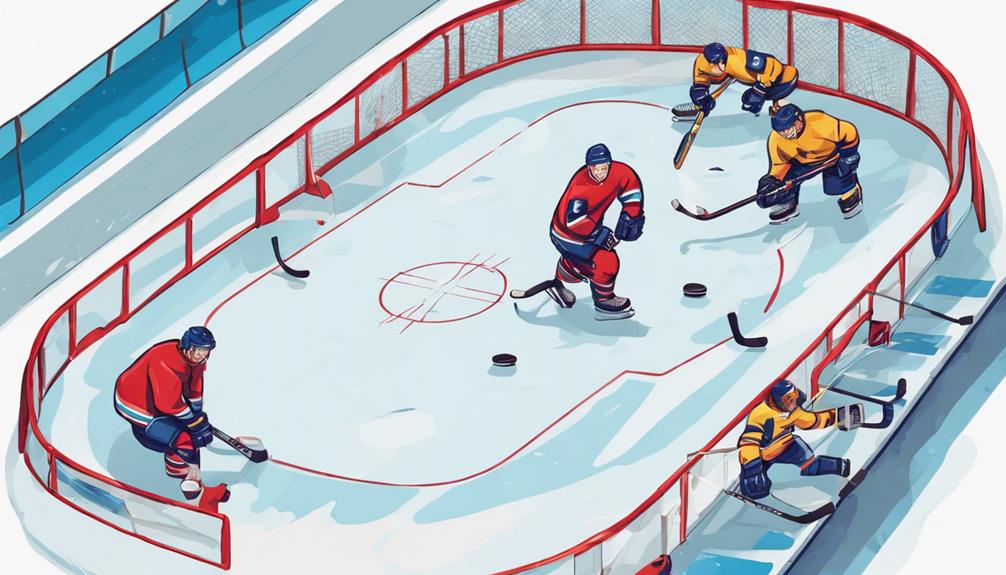In the fast-paced game of hockey, the number of players on the ice plays a crucial role in determining the flow and dynamics of the match. Understanding the standard number of players involved is fundamental, but what happens when teams are either at a power play or penalty kill?
How do strategies shift during empty net situations, and what about the calculated risk of pulling the goaltender? Overtime brings about player adjustments that can alter the course of the game.
Stay tuned to uncover the intricate details of player substitutions and line changes that could tip the scales in an intense hockey match.
The Standard Number of Players
In professional ice hockey, the standard number of players on the ice during gameplay is six, consisting of five skaters and one goaltender.
Player positioning in hockey is crucial for both offensive and defensive strategies. Skaters are strategically positioned to maintain offensive pressure while being mindful of defensive responsibilities. Forwards typically play closer to the opponent's goal, aiming to score, while defensemen focus on protecting their own goal and initiating offensive plays.
Understanding player positioning allows teams to execute effective offensive strategies, such as cycling the puck, setting up screens, and creating scoring opportunities.
Power Play and Penalty Kill
During power play and penalty kill situations in ice hockey, teams strategically adjust their player formations to capitalize on advantages or defend against disadvantages.
Special teams dynamics play a crucial role in these situations, as teams with a player advantage on the power play aim to create scoring opportunities, while teams on the penalty kill focus on limiting their opponent's chances.
The strategic advantage lies in the ability to control the puck, create passing lanes, and maintain defensive positioning effectively.
Teams often deploy their top offensive players during power plays to maximize scoring potential, while penalty-killing units prioritize players with strong defensive skills.
Understanding and executing these special teams' strategies can significantly impact the outcome of a game.
Empty Net Situations
When a team pulls their goalie for an extra attacker, known as an empty net situation in hockey, strategic decisions and calculated risks come into play to either secure a lead or attempt to tie the game. This move shifts the dynamic on the ice, creating a risk versus reward scenario. Teams must weigh the advantage of having an extra skater against the vulnerability of an unguarded net.
Defensive positioning becomes crucial during these moments as the team with the empty net must balance offensive pressure with the need to prevent the opposing team from capitalizing on the open goal. Coaches often employ specific strategies and player rotations to optimize their chances of scoring while minimizing the chances of conceding.
Goaltender Pulling Strategy
What strategic considerations influence the decision to pull a goaltender during a hockey game?
Goalie strategy plays a crucial role in determining when to pull the goaltender. Coaches often opt to remove the goalie in exchange for an extra attacker when their team is trailing by a goal late in the game. This decision is driven by the desire to increase offensive pressure and create more scoring opportunities.
By sacrificing the goaltender for an extra skater, teams aim to tilt the ice in their favor and apply intense offensive pressure on the opposing team. However, this strategy comes with risks, as an empty net leaves the team vulnerable to conceding more goals.
Finding the right balance between offensive aggression and defensive security is key in executing a successful goaltender pulling strategy.
Overtime Player Adjustments
Adjusting player positioning and strategy in overtime periods is a critical aspect of maximizing a team's chances of securing a decisive victory in hockey. In overtime, where every move counts, teams must carefully consider player fatigue management and overtime tactics. Strategic player matchups and line adjustments play a pivotal role in gaining an edge over the opponent. Here are key points to keep in mind:
- Efficient player rotations can help maintain energy levels.
- Assessing opponent strategies for counter adjustments is crucial.
- Utilizing versatile players who can adapt to different roles is beneficial.
- Quick transitions between offensive and defensive play can catch the other team off guard.
- Communication among players and coaches is essential for swift and effective changes.
Player Substitutions and Line Changes
Strategically timed player substitutions and line changes during a hockey game can significantly impact the team's performance and overall outcome.
Bench dynamics play a crucial role in managing player fatigue and ensuring that the team maintains a competitive edge throughout the game. Coaches often make quick shifts to keep players fresh and capitalize on strategic opportunities.
Understanding when to make substitutions based on the game situation and individual player performance is key to success. Effective line changes can disrupt the opponent's rhythm, create mismatches, and inject new energy into the game.
Frequently Asked Questions
How Does the Size of the Hockey Rink Impact the Number of Players on the Ice?
The size of a hockey rink significantly influences player positioning and team tactics. With larger rinks allowing for more open space, teams can employ strategic offensive strategies like cycling and spreading out to create scoring opportunities.
Are There Any Rules Regarding Player Substitutions During Stoppages in Play?
Player substitutions during stoppages in play are crucial for strategic adjustments. Coaches manage their benches carefully, considering rotations that optimize player performance. These decisions impact momentum, freshness, and tactical opportunities, influencing the game's outcome.
Can a Team Have More Than One Goaltender on the Ice at the Same Time?
In the intricate dance of hockey strategies, the utilization of multiple goaltenders on the ice simultaneously is a rare sight. Such goalie tandem tactics can be effective in certain situations, offering teams unique rotational advantages and defensive versatility.
How Do Injuries Affect the Number of Players on the Ice During a Game?
In hockey, injuries can significantly impact the number of players on the ice during a game. This can challenge player safety and team performance. Recovery protocols are crucial to ensure injured players return effectively, minimizing disruptions.
Are There Any Specific Strategies Teams Use When They Have a One-Player Advantage on the Ice Due to a Penalty?
When a team gains a one-player advantage on the ice due to a penalty, they employ power play strategies akin to a skilled artist painting masterful strokes. Offensive tactics focus on creating scoring opportunities, while penalty kill strategies emphasize defensive maneuvers to thwart the opponent's advances.









